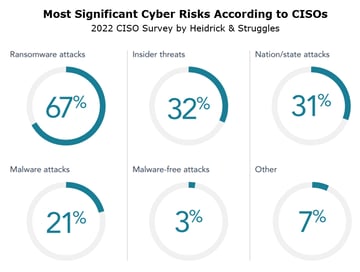Your biggest risk is also your largest asset. The primary catalyst for insider threats? People.
 In all critical infrastructure sectors, insider threats pose a complex and dynamic danger that affects both the public and private spheres. To establish an effective insider threat mitigation program, the initial step is to comprehend and outline these threats. Insider threat is defined by the Cybersecurity and Infrastructure Security Agency (CISA) as the risk that an insider may use their allowed access to harm the department's purpose, resources, people, facilities, information, equipment, networks, or systems. This could happen intentionally or accidentally. Insider threats can take many different forms, including physical harm, espionage, sabotage, theft, and cybercrime.
In all critical infrastructure sectors, insider threats pose a complex and dynamic danger that affects both the public and private spheres. To establish an effective insider threat mitigation program, the initial step is to comprehend and outline these threats. Insider threat is defined by the Cybersecurity and Infrastructure Security Agency (CISA) as the risk that an insider may use their allowed access to harm the department's purpose, resources, people, facilities, information, equipment, networks, or systems. This could happen intentionally or accidentally. Insider threats can take many different forms, including physical harm, espionage, sabotage, theft, and cybercrime.
Most data breaches are the result of insider threats. Traditional cybersecurity plans, policies, procedures, and systems frequently place a greater emphasis on external threats, leaving the company open to inside attacks. Since the insider already has legal access to the data and systems, it is challenging for security experts and software to distinguish between legitimate and destructive behavior.
Malicious insiders possess a unique advantage over other types of attackers due to their intimate knowledge of enterprise systems, processes, procedures, policies, and users. They are well-versed in system versions and the vulnerabilities associated with them. Consequently, organizations must approach insider threats with an equal level of diligence as they do with external threats, recognizing the need for rigorous measures to mitigate the risks they pose.
Cost of Insider Threats - Statistics
 When devising their cybersecurity strategies, contemporary enterprises need to take into account risks beyond those presented by external attackers. Users who are dishonest, careless, or compromised pose a substantial and increasing risk. Insider threat occurrences have increased 44% over the last two years, according to the 2022 Ponemon Cost of Insider Threats: Global Report, with costs per incident rising by more than a third to $15.38 million. According to these statistics, every company should make significant investments in staff monitoring and security threat protection to prevent insider assaults.
When devising their cybersecurity strategies, contemporary enterprises need to take into account risks beyond those presented by external attackers. Users who are dishonest, careless, or compromised pose a substantial and increasing risk. Insider threat occurrences have increased 44% over the last two years, according to the 2022 Ponemon Cost of Insider Threats: Global Report, with costs per incident rising by more than a third to $15.38 million. According to these statistics, every company should make significant investments in staff monitoring and security threat protection to prevent insider assaults.
- Organizations now spend $4.6 million on credential theft, up 65% from $2.79 million in 2020.
- Organizations spend the greatest money on containment because of the increase in the amount of time needed to contain an insider threat incident from 77 to 85 days.
- On an annual basis, incidents that took longer than 90 days to contain ended up costing organizations $17.19 million on average.
Fraud, corporate espionage, sabotage, or abuse of data access to reveal trade secrets to a competitor are all signs of a malevolent insider threat. Even with advanced systems, it can be challenging to recognize the features of insider threats because not all of them are malicious. Users often have permission to access files and data, therefore, effective insider threat detection scans for odd activity and access requests and compares them to benchmarked statistics.
Types of Insider Threats
Why do insiders turn bad? There are many different reasons why malevolent insiders penetrate systems and steal data, but most frequently, they do so for financial gain. However, events might also be the consequence of theft or unsecured access, espionage, retaliation against the employee, or simple carelessness or bad security hygiene. Insider threats can jeopardize any company's information security, although they are more frequent in some industries than others, including the financial, healthcare, and government sectors. Here is a list of the different types of insider threats:
Malicious Insider Threats. Malicious insider threats, sometimes known as turncloaks, have as their main objectives sabotage, fraud, intellectual property theft, and espionage. For monetary, private, or malicious purposes, they willfully misuse their privileged access to steal information or damage systems. Examples include a worker who sells proprietary information to a rival or a dissatisfied ex-contractor who infects the company's network with harmful malware.
Malicious insider threats could come from lone wolves or from groups.
- Collaborator: Authorized users who work with a third party to intentionally harm the organization are known as collaborators. The third party could be a rival company, a state, an organized crime group, or a person. The activity of the collaborator would result in the disclosure of private information or the interruption of commercial operations.
- Lone Wolves: Lone wolves are completely self-sufficient and unaffected by outside forces. Because they frequently have privileged system access, like database administrators, they can be particularly dangerous.
Unintentional Insider Threats. Accidental insider security threats can occur due to carelessness. They frequently occur because of human error, poor judgment, accidental aiding and abetting, convenience, malware, stolen passwords, phishing, and other social engineering techniques. Unknowingly exposing enterprise systems to outside attack, the engaged person becomes an unwitting accomplice to potential breaches.
Careless insider threats may be accidental or due to negligence:
- Accidental: This kind of insider unintentionally exposes an organization to risk. Examples include inputting an incorrect email address and unintentionally sending a confidential business document to a rival, unintentionally opening a virus-filled attachment in a phishing email, or inappropriately discarding confidential data.
- Negligence: An insider of this kind recklessly exposes an organization to a threat. Negligent insiders are frequently aware of security and/or IT policies but choose to disregard them, putting the firm in danger. A few instances include letting someone "piggyback" through a secure entryway, losing or misplacing a portable storage device that contained sensitive data, and disobeying instructions to apply security fixes and new upgrades.
A Mole. A mole is an outsider who has obtained access to the organization's systems from the inside. They could impersonate a supplier, partner, contractor, or worker to get privileged access that they otherwise wouldn't be eligible for.
Technical Indicators of Insider Threats
When an insider makes an attack, they may have to compromise security measures or create a hardware or software infrastructure to facilitate their or others' access to the company’s systems or network. . Here are a few warning signs:
- Data access through backdoors. To find back doors, run a backdoor file scan or keep an eye out for outside requests from hackers who might be attempting to utilize the backdoor.
- Equipment or programs that permit remote access. Ensure your employees who work from home or have remote access to important software are not tampering with servers.
- Changed passwords. Check to see whether this is true whenever a user's old password stops working and they suspect it may have been changed. It might have been altered by an internal attacker who wanted to get access to resources the user was authorized to utilize.
- Unauthorized modifications to firewall and antivirus settings. Any time a firewall or antivirus tool's settings change, it may be the consequence of a system insider seeking to create a quick entry point.
- It is best to investigate how and where malware was installed if you find any. Someone from the inside might have placed it there.
- Unauthorized software. It is always a cause for concern when unauthorized software is installed. In many instances, software that appears innocent could be a Trojan horse infection with hidden spyware.
- Attempts to access servers or devices that contain sensitive data. Since you frequently need authorization from the company to access sensitive areas of your network, any attempt to do so could be an insider threat.
How to Detect Malicious Insiders
 Businesses that simply implement monitoring systems for external traffic risk are overlooking internal network risks. To completely protect data and prevent expensive hostile insider attacks, it's crucial to have the appropriate monitoring tools for both internal and external infrastructure.
Businesses that simply implement monitoring systems for external traffic risk are overlooking internal network risks. To completely protect data and prevent expensive hostile insider attacks, it's crucial to have the appropriate monitoring tools for both internal and external infrastructure.
The chances of your organization being the next victim can be decreased by taking the essential cybersecurity precautions to monitor insiders. You can halt harmful insiders or spot suspicious conduct in various ways, for example:
- Based on employee responsibilities and their requirement for data to carry out a job function, apply policies and security access on a need-to-know or minimum necessary privilege basis.
- Keep track of both successful and unsuccessful access requests.
- Utilize monitoring and cybersecurity tools that can send alerts and notifications when users engage in dubious behavior.
- Install infrastructure that especially keeps an eye on user activity for illicit data access and insider threats.
You must constantly monitor all user behavior and respond to issues if they occur to stop insider threats, both purposeful and unintentional.
Insider Risk Management
Since they are hidden from typical security solutions like firewalls and intrusion detection systems, which concentrate on external threats, insider threats might be more difficult to detect or avoid than outside attacks. For example, the security measures in place could not detect the unusual behavior if an attacker takes advantage of an authorized login. Furthermore, if malevolent insiders are familiar with an organization's security protocols, they can evade detection more readily. Organizations should create an insider threat solution with six essential skills to prevent these potential outcomes:
- Detect Insider Threats. Find dangerous user activity by spotting odd behavior.
- Investigate Incidents. Investigate erratic user behavior immediately—not after days.
- Prevent Incidents. Real-time user notifications and blocking can lower risk.
- Protect User Privacy. To respect the privacy of employees and contractors and to comply with rules, anonymize user data.
- Satisfy Compliance. Be sure to meet important compliance standards involving insider risks.
- Integrate Tools. For deeper insight, integrate insider threat management and detection with SIEMs and other security solutions.
Instead of relying on a single solution, you should diversify your insider threat detection strategy to safeguard all your assets. A robust system for detecting insider threats incorporates multiple methods to not only monitor insider activity but also effectively sift through numerous warnings and eliminate false positives.
Machine learning (ML) applications can be utilized to evaluate the data stream and rank the most crucial alerts. Digital forensics and analytics technologies such as User and Event Behavior Analytics (UEBA) can aid in identifying, analyzing, and notifying the security team about potential insider risks. Database activity monitoring can help identify policy violations, while user behavior analytics can establish a baseline for typical data access activities.
Summary
Despite often being overlooked, internal threats are equally as perilous as external ones, if not more so.
Insiders who deliberately engage in cyberattacks have a variety of motivations, according to numerous government and commercial case studies. These include monetary gain, vengeance, a desire for power and recognition, a reaction to blackmail, allegiance to other members of the organization, and political ideals.
The occurrence of insider threats is on the rise and, fortunately, an increasing number of companies are recognizing the imminent risks. To mitigate potential hazards, more and more businesses are implementing safeguards that range from conducting background checks on prospective employees, to performing security risk assessments to validate their security postures and their resilience against insider threats.








